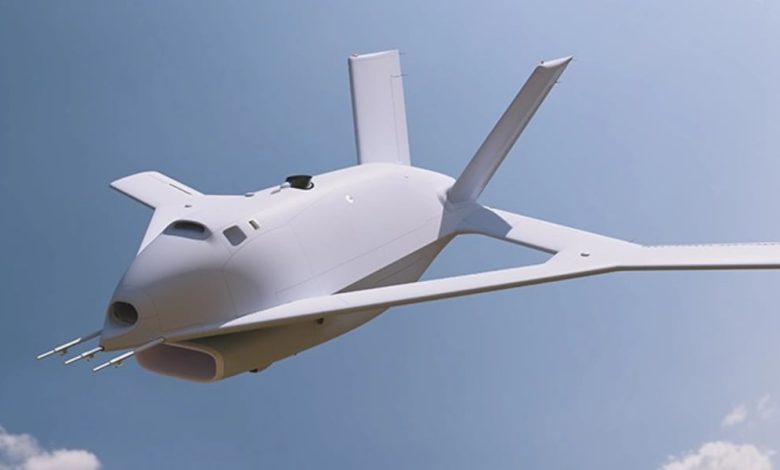Two-year flight delay for DARPA X-plane that steers with air bursts

An experimental DARPA plane that would steer using bursts of air is expected to have its first flight in late 2027, more than two years later than originally planned, after the program was paused and restructured.
The unmanned X-65, being built by Boeing subsidiary Aurora Flight Sciences as part of a Defense Advanced Research Projects Agency program, is designed to test a concept called “active flow control” to steer an aircraft.
This plane will not have mechanical flaps and rudders in its wings or tail to control its pitch, roll and yaw, as a conventional aircraft does. Instead, it is meant to use small air bursts to create a speed bump that alters how the air flows over the plane’s wings, which causes it to shift. The air bursts themselves do not push the wings, as do a spacecraft’s thrusters.
DARPA hopes the technology demonstrated with this program, called Control of Revolutionary Aircraft with Novel Effectors, or CRANE, will allow aircraft designers to rethink how they build planes and design maneuvering systems. This system is intended to be more energy efficient, improve aerodynamics, and reduce the weight and mechanical complexity of aircraft.
DARPA announced in January 2023 that it had awarded a $42 million contract to Aurora Flight Sciences to start detailed design of an aircraft using active flow control technology. Aurora is a Boeing subsidiary, located in Manassas, Virgina, that specializes in developing advanced innovative designs for aircraft and uncrewed systems.
The program passed a critical design review in late 2023 and moved on to its third phase, in which Aurora received another contract to start building a full-scale experimental prototype to test the technology.
In January 2024, Aurora and DARPA announced that fabrication on the demonstrator was already under way at Aurora’s facilities in West Virginia and Mississippi, and was expected to start flight tests in summer of this year. It would have a 30-foot wingspan, weigh 7,000 pounds, and could fly at speeds up to Mach 0.7, or more than 500 miles per hour, they said. DARPA said the plane was expected to be rolled out of the factory for testing early this year.
The program hit troubles, though.
The costs to produce the prototype aircraft for test flights ended up being higher than expected, a DARPA spokesperson told Defense News, so earlier this year, DARPA chose to “strategically pause” the X-65’s development and reevaluate the program, the spokesperson said.
“DARPA programs are high-risk by nature,” the spokesperson said. “As with this program, Aurora had to address technical and supply chain challenges, resulting in added development time.”
During that pause, DARPA said, it restructured the program into a partnership with Aurora, in which the company became a “co-investor” in the X-65. That new arrangement was finalized in August.
“Aurora’s investment in the X-65, through this program’s restructuring, ensures DARPA’s CRANE objectives are met,” Christopher Kent, DARPA’s CRANE program manager, said in a statement.
“Demonstrating active flow control in flight opens new design and production possibilities for both military and commercial aircraft,” he said.
The new partnership structure “gets costs back to an affordable rate for the government,” the spokesperson said.
“After we’ve proven the DARPA-hard technical challenge of successfully demonstrating [active flow control technology] for stability and control in-flight via the X-65, Aurora will take over the platform for future test and development.”
But the program is now more than two years behind schedule for reaching its first flight. In a release posted online Thursday morning, Aurora said construction of the plane’s fuselage is on track to be finished in January.
Aurora spokesperson Carmen Smith told Defense News more integration work will need to be done on the X-65 after the fuselage is built, and ground testing is expected to start late next year or in early 2027, with flight tests following in late 2027.
Smith confirmed technical and supply chain challenges were a factor in the program delays, as well as the inherent riskiness involved in working on a DARPA project. Smith also said negotiations with DARPA on the co-investment strategy delayed work on the X-65.
Aurora would not say how much it will spend on the X-65, but Smith said the company and DARPA are investing sufficiently to finish building the prototype, conduct integrated ground testing, and conduct the first flight test.
Fiscal 2026 Defense Department budget documents show DARPA spent $38.3 million on CRANE in fiscal 2024, and another $23.9 million in fiscal 2025, with another $4 million in spending for 2026.
In Thursday’s release, Aurora said the X-65, which it is building in Bridgeport, West Virginia, will have 14 “effectors” across its flying surfaces to produce the needed air bursts.
“We’re excited to continue our longstanding partnership with DARPA to complete the build of the X-65 aircraft and demonstrate the capabilities of active flow control in flight,” Larry Wirsing, Aurora’s vice president of aircraft development, said in the release.
“The X-65 platform will be an enduring flight test asset, and we’re confident that future aircraft designs and research missions will be able to leverage the underlying technologies and flight test data.”
Stephen Losey is the air warfare reporter for Defense News. He previously covered leadership and personnel issues at Air Force Times, and the Pentagon, special operations and air warfare at Military.com. He has traveled to the Middle East to cover U.S. Air Force operations.







